Happy Tuesday! Thanks to everyone who reached out yesterday to share your thoughts on our COVID-19 data, and whether we should keep the charts in the newsletter as the case numbers continue to decline.
It’s a simple process for us at this point, and since so many of you have made it a part of your morning routine, we’ll keep it up for a while yet. As one of you wrote: “Let’s watch victory over this damn thing happen day-by-day.”
Quick Hits: Today’s Top Stories
-
European Union leaders sanctioned Belarus on Monday, banning the country’s airlines from using EU airspace and airports and encouraging EU-based airlines to avoid Belarusian airspace. The move came a day after the Belarusian government—led by President Alexander Lukashenko—forced a Ryanair plane carrying 26-year-old opposition journalist Roman Protasevich to land in Minsk so authorities could arrest him. President Joe Biden added yesterday he “welcomes” the EU’s actions, and has “asked [his] team to develop appropriate options to hold accountable those responsible.”
-
The White House announced Monday it is doubling the amount of federal government spending directed toward nationwide preparations for hurricanes and extreme weather events from $500 million to $1 billion. The National Oceanic and Atmospheric Administration (NOAA) said earlier this month there is a 60 percent chance this year’s Atlantic hurricane season will be “above normal,” with 13 to 20 named storms expected.
-
The National Guard is expected to fully vacate the U.S. Capitol grounds this week after nearly five months of guarding the premises following the January 6 attack on the Capitol.
-
New York City Mayor Bill de Blasio said Monday that the city will not offer remote learning for K-12 schools in the fall, becoming one of the first major cities to entirely do away with pandemic-style online learning ahead of the next school year.
-
The United States confirmed 23,485 new cases of COVID-19 yesterday per the Johns Hopkins University COVID-19 Dashboard, with 3.1 percent of the 750,076 tests reported coming back positive. An additional 623 deaths were attributed to the virus on Monday, bringing the pandemic’s American death toll to 590,516. According to the Centers for Disease Control, 22,744 Americans are currently hospitalized with COVID-19. Meanwhile, 1,170,314 COVID-19 vaccine doses were administered yesterday, with 163,907,827 Americans having now received at least one dose.
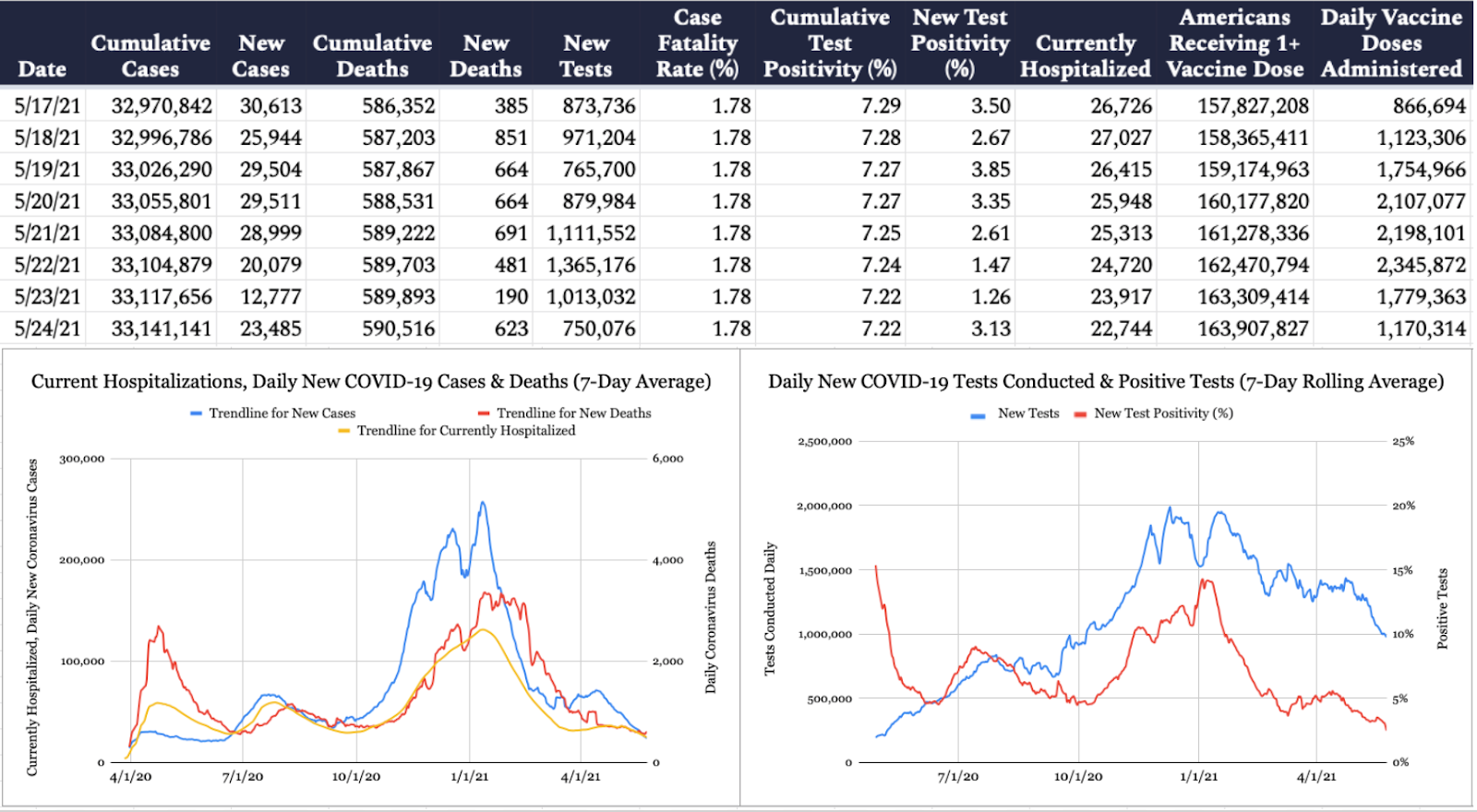
A Closer Look at the Origins of COVID
In mid-February 2020—weeks before COVID-19 upended life as we knew it in the United States—Sen. Tom Cotton went on Fox News to discuss the possibility that the virus then starting to make headlines around the world had emerged from a research facility in Wuhan, China.
“Now, we don’t have evidence that this disease originated there, but because of China’s duplicity and dishonesty from the beginning, we need to at least ask the question to see what the evidence says,” the Arkansas Republican said. “And China right now is not giving any evidence on that question at all.”
A news article in the Washington Post slammed Cotton for “repeating a coronavirus conspiracy theory that was already debunked.” The New York Times’ headline was similar: “Senator Tom Cotton Repeats Fringe Theory of Coronavirus Origins.”
But 15 months (and 590,516 American deaths attributed to COVID-19) later, the rest of the country seems ready for the conversation Cotton wanted to have more than a year ago.
A few weeks back, we linked to a Medium post from veteran science journalist Nicholas Wade that dug into the two main theories about COVID-19’s origin: that it jumped naturally from animals to humans, or that it escaped from a lab in which it was being studied. Wade noted that there is “no direct evidence” for either theory, but argued that most of the circumstantial clues pointed toward the latter. “It’s documented that researchers at the Wuhan Institute of Virology were doing gain-of-function experiments designed to make coronaviruses infect human cells and humanized mice,” he wrote. “This is exactly the kind of experiment from which a SARS2-like virus could have emerged. The researchers were not vaccinated against the viruses under study, and they were working in the minimal safety conditions of a BSL2 laboratory. So escape of a virus would not be at all surprising. In all of China, the pandemic broke out on the doorstep of the Wuhan institute.”
A few weeks later, longtime (until recently) New York Times science reporter Donald McNeil published a response on his own Medium page, admitting he initially gave little credence to Wade’s interpretation of events before reassessing his priors. “The deeper I read into the papers and articles Nick cited, the clearer it became how much new information had trickled out in the last year,” McNeil said. “I now agree with Nick’s central conclusion: We still do not know the source of this awful pandemic. We may never know. But the argument that it could have leaked out of the Wuhan Institute of Virology or a sister lab in Wuhan has become considerably stronger than it was a year ago, when the screaming was so loud that it drowned out serious discussion.”
What explains the initial skepticism toward what is now more or less considered a plausible theory in mainstream circles? For starters, the World Health Organization all but dismissed it out of hand last year—and the extent to which the WHO was simply echoing Chinese Communist Party talking points was not yet fully understood. The accidental lab leak hypothesis was also often melded together in its opponents’ minds with a far more nefarious—and less probable—one: that Chinese scientists intentionally engineered SARS-CoV-2 as a bioweapon to unleash on the world.
But perhaps most importantly, the COVID-19 origins debate was, as these things almost always are, sucked into our hyperpolarized domestic politics. In the earliest days of the pandemic, President Donald Trump—who at that time was still primarily focused on inking a trade deal with Beijing—repeatedly praised China for its “efforts and transparency” in containing the virus, going out of his way to thank Chinese President Xi Jinping “on behalf of the American People.” But once it became clear that the virus posed a real threat to the United States and risked becoming a political liability, Trump changed his tune, pinning COVID-19’s spread on “the incompetence of China, and nothing else.” Many on the political left and in the media dismissed new information on the origins of COVID-19 as part of this new campaign.
Too often, that meant real reporting on the COVID-19 origin story was downplayed or dismissed. Back in mid-April 2020, Washington Post reporter and columnist Josh Rogin reported on the existence of State Department cables that had raised concerns in real time about safety at the Wuhan labs. “Two years before the novel coronavirus pandemic upended the world, U.S. Embassy officials visited a Chinese research facility in the city of Wuhan several times and sent two official warnings back to Washington about inadequate safety at the lab, which was conducting risky studies on coronaviruses from bats,” Rogin reported. “ The cables have fueled discussions inside the U.S. government about whether this or another Wuhan lab was the source of the virus—even though conclusive proof has yet to emerge.” Rogin noted that a press release from the lab confirming the January 2018 visit of a U.S. diplomatic and scientific team was taken off of the lab’s website.
Changes in public perceptions of the lab leak theory have accelerated with President Biden in office. “We have repeatedly called for the WHO to support an expert-driven evaluation of the pandemic’s origins that is free from interference or politicization,” White House Press Secretary Jen Psaki told reporters yesterday. A WHO report published a few months ago reaffirmed the organization’s support for the more natural animal-to-human theory—and determined a lab leak to be “extremely unlikely”—but even WHO Director General Tedros Adhanom Ghebreyesus wasn’t satisfied with the level of access the Chinese government granted international researchers. (Check out this piece from Jeremy Page, Betsy McKay, and Drew Hinshaw on the limitations investigators faced—and this February piece from Andrew about China’s significant political pressure on the WHO.)
“Although the team has concluded that a laboratory leak is the least likely hypothesis, this requires further investigation,” Ghebreyesus said in a late-March statement. “I do not believe that this assessment was extensive enough. Further data and studies will be needed to reach more robust conclusions. … Let me say clearly that as far as WHO is concerned all hypotheses remain on the table. This report is a very important beginning, but it is not the end. We have not yet found the source of the virus, and we must continue to follow the science and leave no stone unturned as we do.”
The Wall Street Journal turned over a few more stones on Sunday, reporting that a “previously undisclosed U.S. intelligence report” found three researchers at China’s Wuhan Institute of Virology sought hospital care in November 2019 after becoming sick “with symptoms consistent with both Covid-19 and common seasonal illness.” If those three truly were hospitalized with COVID-19, the report would certainly appear to tip the scales more in the direction of the lab leak theory. For what it’s worth (not much), a Chinese official at the Wuhan Institute of Virology told the state-run Global Times the report is “groundless” and a “complete lie.”
But the Journal’s report does come with plenty of caveats that demonstrate how difficult it will be to get to the bottom of this with any degree of certainty. First, as the story notes, it is fairly routine for people in China to skip doctor’s offices and seek medical treatment directly at the hospital “because they get better care there or lack access to a general practitioner.”
As for the story’s sourcing, it relies on a handful of anonymous intelligence officials who express varying degrees of confidence in the assessment—and disagree on whether the intel was gathered by the U.S. government or “provided by an international partner.”
Matt Tait, a cybersecurity expert and former British intelligence official, told The Dispatch yesterday to be wary of stories based on unnamed intelligence sources. “The intelligence community in the U.S. is enormous, and the consequences of it being enormous is that it has vast, vast quantities of information with varying quality across the board,” he said. “You can find someone in the intelligence community that has a document somewhere that says pretty much anything that you want, but that doesn’t mean that that’s true, and it doesn’t mean that the intelligence community believes it’s true.”
“A statement this big, that the Chinese government manufactured something which has led to the death of half a million Americans, that would be an extraordinary thing if it was true—like absolutely colossal ramifications globally,” he added. “And if it’s true, then the intelligence community should level with the American public that they believe it’s true.”
More Maneuvering on Iran’s Nuclear Program
When President Biden entered the White House in January, he did so with lofty ambitions of cajoling the Iranian regime into a “longer and stronger” diplomatic safeguard against nuclear proliferation. But the administration’s early months on the job proved difficult. By late February, Tehran had threatened to halt International Atomic Energy Agency (IAEA) inspections entirely if denied banking and oil sanctions relief. A band-aid fix extended the UN watchdog’s oversight mechanisms, albeit with “less access,” and negotiations have been ongoing ever since.
Iran and the international community hit another snag on the nuclear front Sunday as February’s temporary agreement reached its May expiration date. Preliminary reporting out of Tehran signaled the end of its quasi-cooperation with UN monitoring at various nuclear sites across the country, and the IAEA scrambled to postpone a press conference until an agreement with the Iranian regime was reached.
Rafael Grossi, the IAEA’s director general, offered some clarity Monday. According to Grossi, Iran had reached another temporary technical understanding with the watchdog—affording the U.S., European allies, and other foreign parties one month to lift sanctions or lose access to its enrichment activity.
As Iran ratchets up its uranium enrichment in both quantity and quality—to 60 percent at some sites, well above the permitted 3.67 percent—the international community believes that thorough audits on its 18 declared facilities and nine other locations are increasingly crucial. “I would say that if this understanding was important back in February, it was even in my eyes more important now,” Grossi said of the organization’s oversight capabilities, adding that the month-long extension was an “emergency device” and “not ideal.”
According to Jason Brodsky, a senior analyst at Iran International, threats by Tehran to cut off UN access is likely another of its many extortionist negotiating tactics pertaining to the nuclear program. “This is the way the regime operates. They operate through threats, ultimatums, and deadlines—which often turn out not to really be deadlines,” Brodsky told The Dispatch. “There are some in Tehran that think taking a hard line on the nuclear file and continuing to escalate will produce further concessions.”
Already top Biden administration officials have indicated a willingness to offer sanctions relief and other concessions to accelerate reentry into the Iran deal.
The timing for Tehran is opportune. The IAEA monitoring deadline is set for June 24, about a week after the Iranian presidential election. With the Guardian Council poised to release a list of acceptable candidates any day now, some believe the Supreme Leader—Ayatollah Ali Khamenei—may be biding his time until a suitable replacement for President Hassan Rouhani is selected June 18. Reaching a premature agreement with the United States risks lending political capital to a “moderate” contender.
“It’s important to understand that the ultimate decision-maker is Ayatollah Khamenei, the Supreme Leader of Iran, on the nuclear issue. Regardless of what the speaker of parliament says, of what the president says, it’s Ayatollah Khamenei who is driving the agenda both before and after the election,” Brodsky said. “The substance of what is acceptable for Iran before the election will not greatly differ from what’s acceptable after the election.”
Given Khamenei’s age—82 years—the coming shift in power could well result in the last serving president under his reign. This transition of power may factor into Khamenei’s motives for engaging with the international community on Iran’s nuclear program, as he aims to secure both a hardline successor and sanctions relief on his own timeline.
“He wants to ensure that there’s financial stability during the leadership transition,” Brodsky added, “and that figures into his calculus regarding the timing of when the deal will be concluded.”
Worth Your Time
-
Michael Brendan Dougherty took a look at the COVID-19 origin debate in an essay for National Review, focusing specifically on what difference it makes if we learn the virus hailed from a Chinese lab. “If COVID-19 is a man-made disaster, searching for the people, the institutions, and the governments that authored this disaster is not scapegoating, it’s necessary fact-finding before doing justice,” he argues. “What might justice look like in practice? It might include global bans on gain-of-function research. This one measure alone would constitute a kind of quiet revolution, an admission that not every kind of scientific research is in fact beneficial to humanity. The reputation of the entire scientific enterprise itself would suffer immensely from the fallout. … And if subsequent research and investigations can show that actions of the Chinese government—its stonewalling, and its manipulation of the World Health Organization at the outset of the pandemic—contributed to an overall worse global outcome, it might be time to bring up the word ‘reparations’ in international affairs again.”
-
Former Indiana Gov. Mitch Daniels may no longer be an elected official, but he’s still got plenty of wisdom to share. “The risk of failure, of a hit to one’s reputation, or just that the gains don’t outweigh the costs, all these can deter or even paralyze a person out of fulfilling the responsibility someone has entrusted to them,” he said in his remarks at Purdue University’s commencement earlier this month. “This last year, many of your elders failed this fundamental test of leadership. They let their understandable human fear of uncertainty overcome their duty to balance all the interests for which they were responsible. … Pursuing one goal to the utter exclusion of all others is not to make a choice but to run from it. It’s not leadership; it’s abdication.”
-
As we’ve covered at great length in this newsletter, there was a sustained effort to overturn the result of the 2020 presidential election—an effort that failed thanks to a handful of election officials in key battleground states choosing loyalty to the Constitution and rule of law over partisanship. But as Zach Montellaro reports in a piece for Politico, several of the Republicans who championed election lies in late 2020 and early 2021 are now running to unseat the officials who stood their ground. “The campaigns set up the possibility that politicians who have taken steps to undermine faith in the American democratic system could soon be the ones running it,” he writes.
Presented Without Comment
Also Presented Without Comment
Toeing the Company Line
-
On the site today: David Kramer and Eric Edelman on Alexander Lukashenko’s reign in Belarus, Andrew on Mark McCloskey’s bid for the U.S. Senate, and Ryan on the race to replace Sen. Pat Toomey in Pennsylvania.
Let Us Know
It was on this date one year ago that George Floyd was murdered by then-Minneapolis police officer Derek Chauvin, sparking a summer of activism, protests, and riots in cities across the country.
A Marist poll published last week found 42 percent of Americans believe race relations in the United States to be worse than they were a year ago, compared to just 17 percent who believe them to be better. What do you think? Have you changed your mind about anything to do with racial politics over the past 365 days?
Reporting by Declan Garvey (@declanpgarvey), Andrew Egger (@EggerDC), Haley Byrd Wilt (@byrdinator), Audrey Fahlberg (@FahlOutBerg), Charlotte Lawson (@charlotteUVA), Ryan Brown (@RyanP_Brown), and Steve Hayes (@stephenfhayes).

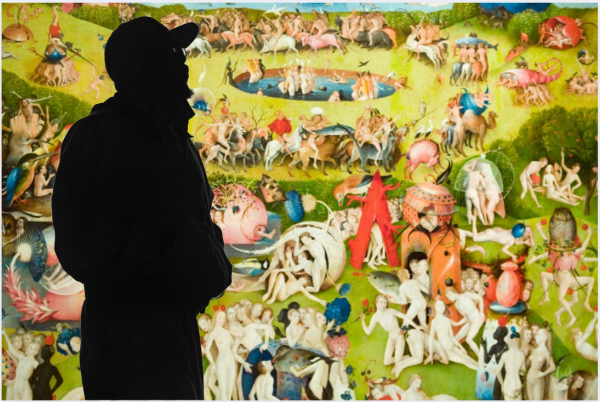
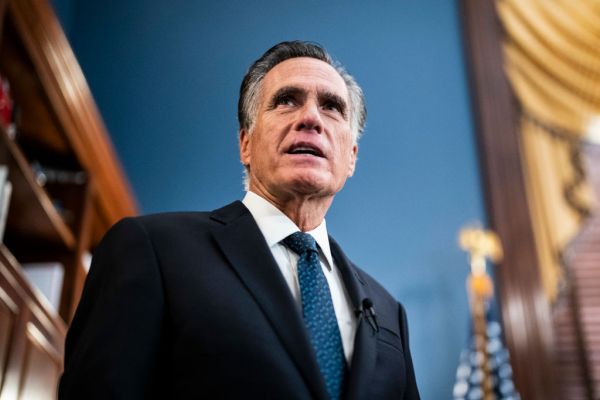

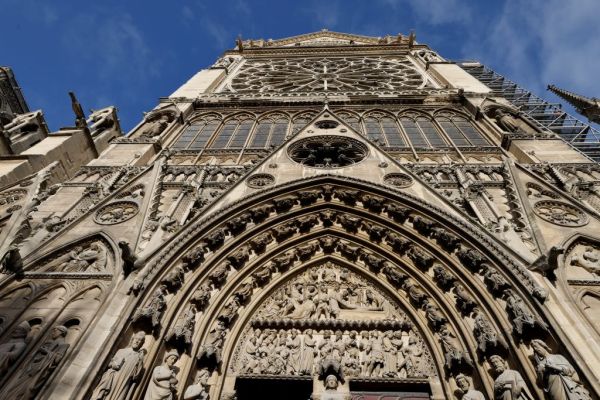
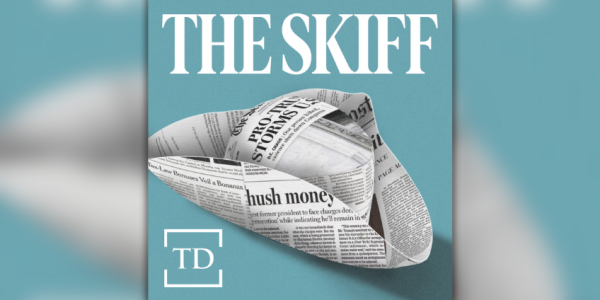
Please note that we at The Dispatch hold ourselves, our work, and our commenters to a higher standard than other places on the internet. We welcome comments that foster genuine debate or discussion—including comments critical of us or our work—but responses that include ad hominem attacks on fellow Dispatch members or are intended to stoke fear and anger may be moderated.
You are currently using a limited time guest pass and do not have access to commenting. Consider subscribing to join the conversation.
With your membership, you only have the ability to comment on The Morning Dispatch articles. Consider upgrading to join the conversation everywhere.